|
|
Laser
F/X On-line Newsletter - Digest

Fourth
quarter 2001
Items removed from the Newsletter
section of the Backstage Area originally posted during the
fourth quarter [October, November, December] 2001.
NOTE: Links on destination
sites are often changed. We provide the digest pages for
archival purposes and the links to external sites were working
when the material was originally published but may no longer
be working.
What's New
New products and services of interest to laserists. Submit your new product information and images in
.gif or .jpg format to our E-mail or contact us.
MediaLas
Laserproducts presents 360° laser scanhead
Autumn 2001. MediaLas Laserproducts GmbH,
located in Hechingen/Germany, presents their latest
development, the first projector of the new Intellilas series,
the SPUTNIK VX. Introduced on London´s Plasa show, the
SPUTNIK integrates a 360x300° moving head, a fast laser
projector system and a very bright 100mW solid state laser.
This first of its kind Intellilas projector is the new
breakthrough in laser entertainment.
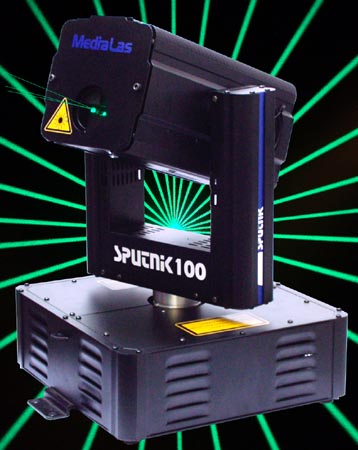
The very bright laser offers performance for
medium to large discotheques. Input is via ILDA standard DB25
connector and is plug and play compatible with the popular
Lasershow Designer by Pangolin Laser Software. The control
inputs are 1:1 to Pangolin, but are also compatible with any
ILDA standard graphics system. The resolution of the Pan and
Tilt functions can be changed from 8bit to 16bit. Both
channels can be inverted on the base. Fast hybrid stepper
motors ensure a smooth movement, even at long throw distances.
There is no need for extra cooling or high power. The head
consumes just 200W or electrical power and contains its own
heatsink system. Even in high ambient temperature locations
such as discotheques, the SPUTNIK VX does not need any special
cooling. The typical lifetime of 5,000 hours ensures a safe
and affordable operation for years.
Unlike other laser projectors, one single SPUTNIK can fill a
whole discotheque with laser effects. Imagine, what you can do
with 2 or more projectors! The SPUTNIK is available from
MediaLas Germany or dealers worldwide. Suggested retail starts
at $ 6,990.00 US$
MediaLas Laserproducts GmbH
Neue Rottenburger Str. 37 - 72379 Hechingen
Ph. +49-7471-91661 Fax +49-7471-91666
www.medialas.com
Pangolin
Announces Software Updates
Pangolin is proud to announce the release of
the latest version of LD2000 and Lasershow Converter MAX --
version 2.11. Since our last major release of LD2000
(version 1.32), this version contains over 100 new features,
enhancements and bug fixes. A few of the new features are:
-
Support for up to 20 projectors (scanner
pairs)
-
Ability to set projector settings and
palette separately for each installed projector
-
A bold new concept called Projection Zones
which allows you to easily re-configure a show for any
number of projectors or projector locations
-
A new concept called Beam Attenuation
Maps, which (if used properly) can improve audience and
airspace safety
-
Security for frame files -- allows the
artist to control the distribution of their work
-
More ways to categorize and search for
frames
-
A variety of Timeline improvements
-
A new animation method in the timeline
editor
-
New actions in the effect editor
-
Many improvements and changes across the
entire LD2000 product line
Although Lasershow Converter MAX is
continually being updated, version 2.11 includes the following
enhancements:
-
Real Time Rendering of scenes with up to
5000 faces
-
A new "Ultra-smooth rendering"
option, particularly well suited for laser display
-
Improved rendering quality for certain
scenes that are particularly challenging
-
Support for all versions of 3D Studio MAX
from version 3.0 to version 4.2
-
Much better support for European versions
of 3D Studio MAX and European versions of Windows
Along with the great software enhancements,
the help files for all products have been updated, not only to
reflect the latest features, but also in overall content. We
highly recommend that everyone review the "latest
features" and "what's new" section in each
product's help file.
Perhaps the best part of these new releases is the price.
LD2000 version 2.11 can be downloaded absolutely free to
registered users. Lasershow Converter MAX updates are handled
privately through an email update scheme, but these are also
free to registered users of Lasershow Converter MAX. For more
information about these new releases, go to: http://www.pangolin.com/downloads_LD2000_updates.html
JDS
Uniphase announces new Air-Cooled Argon Laser
|
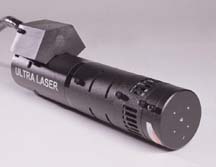
|
| Extended
lifetime Universal power supply Hard-sealed tube design |
JDS Uniphase has introduced a new line of
air-cooled argon-ion lasers — the Ultra Series. These lasers
provide improved lifetime, performance and flexibility for OEM
laser applications. They are the only commercially available
air-cooled argon lasers to provide a standard 24-month or
8000-hour warranty, to lower the cost of ownership for
customers by providing significantly longer lifetimes.
The Ultra series provides
longer lifetimes through innovations in hard-sealed laser tube
design that reduce operating current for a given optical
power. Available in round or square packages, the Ultra laser
provides easy OEM integration because of its small,
lightweight design. The series conforms to CE, UL, TUV, IEC
and CDRH regulatory requirements. In addition, the power
supply offers universal input voltage/line frequency (90 to
265 Vac, from 47 to 63 Hz) with power factor correction. This
makes each laser universally applicable, completely
eliminating the need for country-specific power supplies.
Info: JDS Uniphase www.jdsunph.com
DMX512
decoder board
Logic Systems, Inc. announces its DMX512
decoder board. This board will enable users to decode DMX512
protocol signals and derive 16 individual digital and 2 analog
outputs. The digital outputs can either be 5vdc TTL compatible
or open collector transistors capable of up to 30vdc @ .1
amps. The analog outputs are 0-10vdc with individual trim pot
for gain. The digital and analog outputs each have their own
output connector. This board requires the user to supply a
voltage of +12vdc @ 50ma. If using the GW-RLY16 relay
interface card, the current requirement is 600ma.
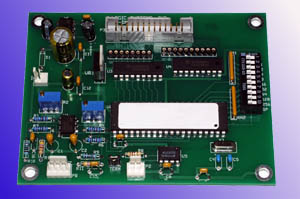
Part # GW-DMX1602 - List price $120.00 each
plus shipping and handling.
Info: Craig Nelson - craig@lsione.com
New
Water Screen from LOBO
The German laser specialist
LOBO electronic developed an outdoor projection system for
multimedia applications.
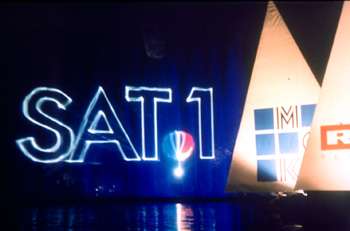
Floating version
of LOBO´s Outdoor Water Screen in a lake
Nearly everyone who deals
with show-technology knows this problem: Large projection
screens for slide, video or laser projection are very
difficult to install job-site. In addition, enormous wind
power must be taken into account at open air events for the
static's of the ground support truss and the
frame-construction of the projection screens. The physical
limits are reached relatively quickly, not considering the
time-consuming and expensive set-up and inspection procedures.
Fed up with all these problems, the company
LOBO electronic from Aalen, Germany developed a very flexible
screen-system based on water as projection medium. This
approach uses 2m-long alignable water distribution segments,
each equipped with 8 water nozzles to generate a wall of water
jets. As the water screen itself is extremely transparent the
rear-projected images seem to float freely in the air.
Each distribution segment can be
supplied with up to two submersible pumps, which are able to
carry the water to a height of up to 15 m depending on the
kind of nozzles. Thus the falling water can be used as a
screen for rear projection. As far as the nozzles are
concerned, there is a large variety of different types which
are selected depending on the used media, the height of the
screen and the wind force. The nozzles can be changed and
adjusted by the user without any tools by the help of
quick-adjustment looks. The use of multiple pumps not only
allows to work with extremely high water pressures, it also
increases the operational reliability.
|
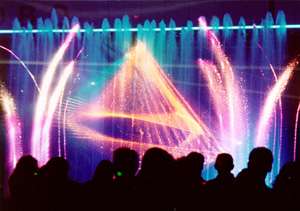
As the screen
does not cause very much water splash, it also can be
used to generate beautiful effects in indoor use
|
In contrast to all other systems on
the market LOBO's water screen allows a perfect reproduction
of the image in all areas of its rectangular surface and it is
almost not affected by wind. So the user needs only a water
basin, which is only two meters larger than the screen itself.
Furthermore the modular design of the system allows also to
realize screens of any width or even curved projection
surfaces.
Info: mail@lobo.de
"The
Assistant" by Kozmic Lazer Show.
We recently designed a
Widget. "The Assistant" by Kozmic Lazer Show.
It allows you to continue to communicate in a noisy or noise
sensitive environment. Such as during a sound check or
speech rehearsals.
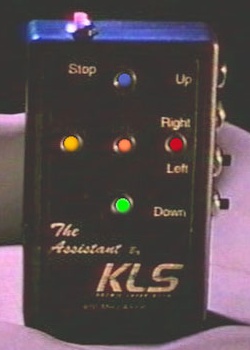
It
was spawned from a show where a technician was in the catwalk
focusing laser mirrors. The sound guy proceeded to envelope
the arena with pink noise for the next twenty minutes.
We sat helpless not being able to communicate via radios or
visually, due to the darkness. It was during this time I
sat and vowed that this could never happen again. Thus I
came up with "The Assistant."
A technician can be in a catwalk or across
the ballroom and press the Up (Blue=Sky), Down (Green=Grass),
Right (Red=Right), Left (Yellow=Left), and Stop (Strobe)
buttons to direct the other person doing the alignment.
They can silently inform the other person which direction to
move the beam, to hit the center of the mirror.
The high output LED's are visible 200-300 feet away.
We use it for assisting in laser mirror alignments, but it can
be used in any application for positioning gear in a silent or
noisy environment. $175.00 retail
Info: MRLASER800@aol.com
World
Scan
News items about
laser show technology, installations and special events/shows from around
the world as well as social items relating to laserists. Our
"Pluses" items cover laser items from the mainstream
media.
Laser
Fantasy Shines At Nintendo E3 Booth
Nintendo of America, looking to add some extra pizzaz to their display at the recent Electronic Entertainment Expo (E3) in Los Angeles, hired Laser Fantasy International (LFI) to add sizzle to their tradeshow booth.
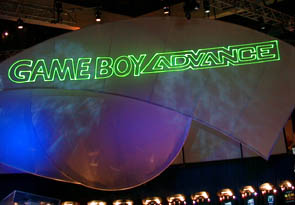 |
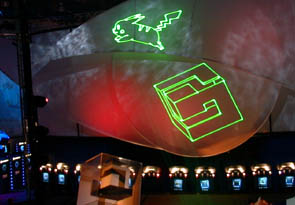 |
|
Lasers
in the Nintendo booth at the 2002 E3 show - Photos
courtesy of Laser Fantasy International |
Paul Torgeson, Senior Designer at
LFI, planned to accent Nintendo’s booth with laser graphics from an Infinity YAG 1000 Laser System (I-1000). The portable 3 watt I-1000 is ideal for projecting logos, graphics, and text in any environment. It was used to enhance Nintendo’s unveiling of their latest products. LFI projected animations of the GameCube and GameBoy Advance as well as imagery of Mario, Pokemon and Donkey Kong in the 8 minute show loop.
The lasers once again entertained the crowds as thousands of visitors crowded the tradeshow floor to sample Nintendo’s new video games and the WaveBird wireless controller.
ILDA
presents 2001 "Virtual Awards" via net-cast
In light of the tragic events of 11 September
2001, the ILDA board of directors had decided to cancel the annual
ILDA meeting which was was originally scheduled for November
11th to 14th in Orlando, Florida. Instead, the results
of the awards competition were presented in the Nov. issue of
The Laserist, ILDA's quarterly print publication and Web site.
Many ILDA members still wanted to see some form of awards
ceremony take place. With a lot of work by ILDA volunteers,
and the help of technology, a "Virtual Awards
ceremony" was staged on the evening of 14 November
2001. The broadcast originated from the facilities of
LSDI in Orlando Florida and featured a three window layout
with live video in one window, a second window for presenting
titles and still pictures, and a chat window to allow members
to interact with each other and the studio in Orlando.
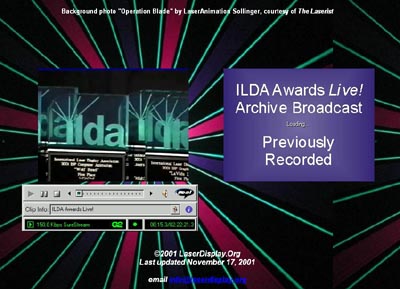
The awards web-cast was recorded and is now available for
viewing [without the chat window] on demand at http://www.laserdisplay.org/
- The free Real Player plug-in for your browser is required
for viewing.
Pulses
CALL FOR PAPERS AND
PRESENTATIONS AT THE 2000 ILDA ADVANCED TECHNOLOGY WORKSHOP (ATW)
You are invited to present a new product or interesting technology
at the upcoming Advanced Technology Workshop of the International Laser
Display Association (ILDA).
This invitation is extended to manufacturers of laser or lightshow-related
products, research labs with innovative ideas for laser or lightshow-related
technologies and other individuals who wish to assess the applicability of
non-laser related technologies to the field of laser display.
The Advanced Technology Workshop, now in its tenth year, is a forum for
technology development as well as a showcase of new products. Vital laser
display products are developed and commercialized at the ATW, where
technology and product manufacturers come together with laser display
industry developers. Manufacturers can perform market-wide research and
determine key direction and parameters, and ILDA members can learn about the
latest technology developments.
Paper presentations are typically 10 to 30 minutes in length. New product
and interesting technology presentations are typically 5 to 15 minutes in
length. There is an additional 3 to 5 minutes given at the end of each
presentation for questions.
ABOUT THE CONFERENCE
The ILDA conference is the annual meeting of the International Laser Display
Association (ILDA). ILDA members participate in many aspects of laser
display technology, with a strong focus on the laser entertainment and
commercial information display industries.
The ATW is held as the first event of the ILDA conference and is open to all
members, technical and non-technical alike. The time for the ATW is Monday,
November 12, 09:00 - 12:00 and 1:30 - 4:00. There are other ILDA events
which extend through the end of Wednesday, November 14.
This year, the ILDA conference will be held in Orlando, Florida at the
Tupperware Convention Center. Complete information about the conference
and the conference facility is available at www.laserist.org.
You must be an ILDA member to attend.
REQUIREMENTS
There is no cost to present at the ATW, and ILDA membership is not
required to be a presenter. However, if a presenter wishes to attend any
other events associated with the ILDA conference, he/she must be an ILDA
member. For information on becoming an ILDA member, please visit the ILDA
web site at: www.laserist.org
or contact the ILDA office at: (941) 758-6881.
In order to make sure that the ATW runs as smoothly as possible, and that it
continues to carry a professional image:
-
Once you are accepted as a presenter, you are expected to be present
at your designated time. The scheduling takes into account the
amount of setup time required, as well as the requirements of other
presenters, making it important that we strictly adhere to the schedule.
-
Any presenter wanting to withdraw his/her presentation must
contact the ILDA Technical Committee Chairman in writing no later than
Sunday, September 30.
-
Last minute substitutions will not be accepted.
CONTACT INFORMATION
If you have a new product or interesting technology that you would like
to present, please contact:
William Benner
ILDA Technical Committee Chairman
Phone: (407) 299-2088, Fax: (407) 299-6066
E-mail: William_Benner@email.msn.com
For more information about the ILDA conference, please visit the
ILDA web site at www.laserist.org
or, contact the ILDA office at:
International Laser Display Association
4301 32nd Street West, Suite B-23
Bradenton, FL 34205, USA
Phone: (941) 758-6881, Fax: (941) 758-1605
E-mail: ildadirect@aol.com
Pulses:
Smallest Laser 1,000 Times Thinner Than A Human Hair
emits Blue/UV
A University of California, Berkeley, chemist has grown the world's smallest
laser -- a nanowire nanolaser one thousand times thinner than a human hair.
The laser, one of the first real devices to arise from the field of
nanotechnology, emits ultraviolet light, but can be tuned from blue to deep
ultraviolet.
"The ability to produce high-density arrays of nanowires opens up lots of possible applications that today's gallium arsenide devices can't do," said creator Peidong Yang, assistant professor of chemistry at UC Berkeley and a member of the Materials Science Division at the Lawrence Berkeley
National Laboratory. "This process works, it is ultracheap, and it's the first real application of
nanowires." Yang and his colleagues in the Department of Chemistry at UC Berkeley
and at LBNL reported their development in the June 8 issue of Science.
Gallium arsenide and gallium nitride lasers are today's leading solid state lasers, cheap enough to be used in laser pointers. Made of multilayer thin films, they are several micrometers in size, or 100,000th of an inch. The nanolaser is about 100 times smaller.
Yang and his team grew the lasers, which are pure crystals of zinc oxide, using a standard technique called epitaxy, employed broadly today in the semiconductor industry. In epitaxy, a device is immersed in a hot vapor that is deposited in a very thin layer, sometimes only a few molecules thick.
The scientists painted a gold catalyst onto a piece of sapphire and placed it in a hot gas of zinc oxide (ZnO) -- a compound often used in solid state lasers, but perhaps best known as an ingredient in sunscreens. The gold, when heated, formed regularly spaced nanocrystals that stimulated the
growth of extremely pure zinc oxide wires only 20 to 150 nanometers in diameter. One nanometer is about the diameter of an atom of hydrogen.
The solid wires, which are hexagonal in cross section, grew to about 10 microns in length before the growth process was stopped, typically after two to 10 minutes. A human hair is about 100 microns in diameter. "This technique is very compatible with current industry methods," Yang said.
Under an electron microscope, the arrays of nanowire nanolasers look like bristles of a brush, each bristle an individual laser. Bunched together like this, the nanolasers are bright enough to be used in different applications.
The key to getting these solid state lasers to emit coherent UV light is a perfectly flat tip that acts as a mirror in the way that, from underwater, the water surface acts like a mirror. The end attached to the semiconductor also is a mirror, so that light emitted by excited zinc oxide bounces back
and forth between them, causing more molecules to emit and amplifying the light. The amplified photons produced by this stimulated emission
eventually pass through the mirrored free end, producing a flash of UV light.
Though Yang now must use another optical laser to excite the zinc oxide molecules so that they will emit UV light
he hopes eventually to "pump" the zinc oxide with electrons. Electron pumping is necessary for a laser to be integrated into an electronic circuit.
A short-wavelength ultraviolet laser also could increase the amount of data that can be stored on a high-density compact disk, just as the advent of blue-light gallium nitride lasers boosted data
density, and in the field of photonics and optical computing, cheap bright lasers are essential.
Yang said that at this preliminary stage of development, the nanolaser is comparable to or better than the gallium nitride blue laser in terms of ease of manufacture, brightness and much smaller dimensions.
"It basically has high enough intensity to think about making a practical device," he said. Plus it operates at room temperature.
|
Staff changes at
Pangolin Laser Systems
April 16, 2001, Orlando: Pangolin Laser Systems
Inc. announced today that co-founder and company president Patrick
Murphy is stepping down to pursue other opportunities. Co-founder and
former vice president of engineering William R. Benner Jr. has been
named as president and chief technical officer. "I am very
pleased that Pangolin has been able to help the laser display
industry. I am leaving at a time when the company and product line
continues to be very strong," Murphy said. "I hope to
continue to be associated with the industry, since laser has been my
first love ever since the early 1980s."
|
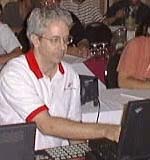
Patrick Murphy
|
Throughout the 1980s, Murphy wrote laser
show software for various computers, starting on a college mainframe and
moving to the Radio Shack TRS-80 and then the Commodore Amiga. In 1988, he
was on the cover of an Amiga magazine that Benner saw. In the article,
Murphy wrote that his software would be better if it had four output
channels. Benner, who had been active in the laser display community since
1985 as laser technician at the Daytona Planetarium, had already developed a
four-channel hardware solution. Benner contacted Murphy, and the two began
collaborating. The first industry-wide demonstration of their Amiga-based
system took place at the 1990 ILDA meeting in Bradenton.
The favorable response spurred further development, with
a Windows-compatible program being introduced in 1993. Interest gradually
increased, and really took off after Lightspeed Design produced
"Creation". The show quality demonstrated what top-level laserists
could do with the program. Soon the Lasershow Designer series became a
mainstream choice for companies around the world. During his career, Murphy
received two ILDA Artistic Awards as well as sharing in some of the
company's numerous ILDA Technical Awards. He served as ILDA President in
1996. He took office less than a month before the FAA's crackdown on outdoor
laser beams, and after his presidency continued work in this area as ILDA
Airspace Issues Coordinator. In recent years at Pangolin, Murphy turned his
attention from programming and business development towards marketing, web
design, and demo show production.
Benner has received or shared in eight ILDA Technical
Awards, covering both his work exclusively and his work at Pangolin. His
patented hardware designs and software products have revolutionized the
component technology and show design programs available to laser light show
producers today. Benner is also a consultant to the industry, working with
show producers on specific projects, as well as manufacturers including NEOS
Technologies, MediaLas, General Scanning and RMB Miniature Bearings. He
currently serves as Chairman of the ILDA Technical Committee. "Patrick
and I have done great things together," Benner noted. "We will
continue to consult with Patrick in areas such as user interface and our
website. Everyone here at Pangolin wishes him the best of luck in his new
endeavors."
Pulses:
DISCLAIMER:
Some of the information in the Backstage area is provided by the
persons or companies named on the relevant page(s). Laser F/X does
NOT endorse or recommend any products/services and is NOT
responsible for the technical accuracy of the information
provided. We provide this information as a service to
laserists using the Backstage area.
[ Introduction
| World Scan | What's New
| Special Reports
| Virtual Visits | General Articles
| Digest ]
|